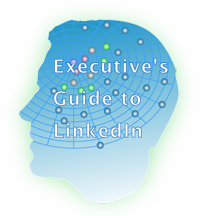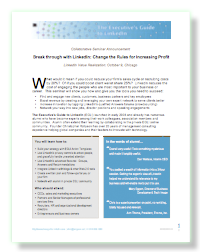Multidimensional Innovation—Inviting Collaboration—Crowdsourcing via LinkedIn
 In August, I have been intensely involved in developing the next iteration of executive LinkedIn training (the Executive’s Guide to LinkedIn, EGLI), which has proven as illuminating as it has fruitful, so I will share key elements of the quick innovation approach I used as well as how Linkedin contributed to it. I believe that by collaborating with EGLI alumni and other people in my network, I have fielded the most innovative and valuable offering ever. I’d love to get your feedback, too! (links below)
In August, I have been intensely involved in developing the next iteration of executive LinkedIn training (the Executive’s Guide to LinkedIn, EGLI), which has proven as illuminating as it has fruitful, so I will share key elements of the quick innovation approach I used as well as how Linkedin contributed to it. I believe that by collaborating with EGLI alumni and other people in my network, I have fielded the most innovative and valuable offering ever. I’d love to get your feedback, too! (links below)
The first seminar series kicked off in March and ended in June, and by all accounts it succeeded in delivering extensive information to relatively large groups in a classroom format (more on the spring/summer series). However, due to the large class size, there was a limited opportunity to draw people out. Actually, we did have significant interaction, but we were limited in how we could apply the information that was our focus.
First Dimension: Delivery, Seminar Group Experience
During the first series, I became aware of the fact that many of the participants were very satisfied in receiving the information and understanding what LinkedIn and social networks could offer executives. The seminar helped them wrap their minds around the significance of LinkedIn and what they might accomplish with it. There was another group, though, that would have been motivated to dive deeper and to apply the material aggressively to impact significant change in how they attained their professional goals. I perceived significant potential in this more demanding group, so I wanted to address their needs and explore where that might lead. Therefore, I focused my innovation approach on creating a more interactive delivery for the material to accommodate the second group. The material (“content”) required little change, so I focused on its delivery.
My experience working with transformation has taught me that when people are experiencing mind-boggling material, they need to play with it, mold it, and make it their own. It would be one thing to create space in which to draw people out, but a big part of the group dynamic would be affected by who was in the room.
Second Dimension: Registration
The general adoption pattern of disruptive innovations shows that early adopters will present before the majority of the market. Since the more interactive seminars would already require smaller class sizes, I thought, “Why not let early adopters self-organize in small groups to do more intensive work?” We could all collaborate on arranging who would be in the room. Use the network effect, and let the network find the people that should be there (of course, I’m a part of the network, too, so I am very involved in inviting and motivating early adopters ,^).
One of the simple visuals I use to describe adoption has the adopters are arranged in concentric circles around an innovation: the early adopters are at the center, touching it and talking about it. The next circle out is looking over their shoulders intermittently; they have some interest but are content to be in look-over-the-shoulder mode. The third circle has no interest and is looking outside. They will focus attention on the innovation only when there are persistent and numerous cries of wonder from the first two circles. Therefore, to create a more intense experience, I had to find that inner circle or, better yet, create a vision and conduit to let them find each other and organize. “Social Networking Registration” is that concept: anyone who hears about a seminar, whether s/he is an individual, works in a company or manages a trade group, can get a group code and invite people with whom s/he would like to learn. To add some energy to it, I instituted pricing that varies with the size of the group.
LinkedIn Role
 I soon learned that these concepts were new thinking and that they were difficult to explain on a static medium like paper or a website. The first iteration raised as many questions as answers. To drill down more methodically, I asked a private LinkedIn question (in the Answers forums, ask a question in the normal way, but check the box to “Only share this question with connections I select”); I asked some of my trusted connections to review my draft announcement. I asked 200 people, comprised of alums, networking enthusiasts, marketing executives, designers, architects… An astoundingly high percentage gave feedback, many on multiple occasions. I also posted a link on the EGLI private community and got additional feedback there.
I soon learned that these concepts were new thinking and that they were difficult to explain on a static medium like paper or a website. The first iteration raised as many questions as answers. To drill down more methodically, I asked a private LinkedIn question (in the Answers forums, ask a question in the normal way, but check the box to “Only share this question with connections I select”); I asked some of my trusted connections to review my draft announcement. I asked 200 people, comprised of alums, networking enthusiasts, marketing executives, designers, architects… An astoundingly high percentage gave feedback, many on multiple occasions. I also posted a link on the EGLI private community and got additional feedback there.
Over a period of a week, we went through about half a dozen iterations of the announcement, and we addressed the entire process of explaining the concept and motivating readers through registration. It spawned the registration website, an FAQ and supporting material. To see the final version, click the illustration, right.
It’s fascinating and inspiring to receive such diverse and on-point feedback on a new concept. A couple other things we did that worked well: be committed to tight cycles. I read and responded to all responses at least once a day. Remember, in a private question, people were not seeing each other’s responses, so we didn’t have the benefit of the network effect. I also wonder if that made it more likely that people would respond, since they didn’t see that anyone else was addressing the question. Another best practice: each new version overwrote the old, so the link to the pdf never changed, and people could easily respond to the latest version. Another must: communicating progress to each person and sharing how their feedback was helping.
Final Thoughts
- This experience served as another proof point of the power of having a strong and diverse LinkedIn network. The network is rapidly addressable and available when you know how to engage it.
- When you ask a “private” question, you can choose up to 200 people in your network, which forces you to be selective. It takes about 15 minutes to go through your address book and click the right boxes, but then LinkedIn does the rest. This is another reason to build a network with purpose. It is your personal network of experts, whom you can ask things that are most important to you and get rapid results.
- By the way, if you’re an early adopter or who someone who is, here is the link to the seminar’s announcement. Enrollment is scheduled to open Tuesday.
- What do you think? I invite you to weigh on both areas of innovation, the delivery method and registration, by commenting below. Thanks.

Leave a Reply
You must be logged in to post a comment.